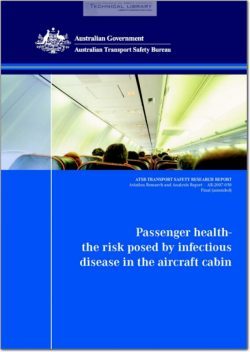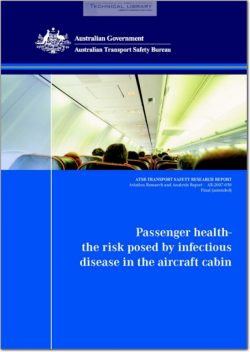ATSB-AR-2007-050

- Version
- 170 Downloads
- 953.87 KB File Size
- 1 File Count
- August 9, 2016 Create Date
- August 9, 2016 Last Updated
Passenger Health - The Risk Posed by Infectious Disease in the Aircraft Cabin

There is a common misconception among the travelling public that if just one
person on board an aircraft has an infection, then all other passengers have a high
risk of acquiring that infection. In March 2007, a 16-year-old girl on board a
Continental Airlines flight from Newark to Hawaii began coughing uncontrollably
prior to take off. Under instruction of the pilot-in-command, the girl was off-
loaded, fearing that she may have contracted an infectious disease (Au, 2007). As
reported in the Honolulu Star-Bulletin, “the captain felt he was acting in the best
interest of the passenger and other passengers on the flight”. Only a day before this
incident, 272 passengers on board a Continental Airlines flight from Hong Kong
were detained at Newark Liberty International Airport amid fears of bird flu. Some
passengers displayed flu-like symptoms, although health officials later said that
these passengers were only suffering from a seasonal flu (Au, 2007; Ball, 2007).
Questions about cabin air quality and the transmission of infectious disease in an
aircraft cabin have been discussed greatly in the past, but the emergence of severe
acute respiratory syndrome (SARS) in 2002-03, and recent outbreaks of avian
influenza in Asia, have increased the importance of these issues to the travelling
public. An increased understanding of the relationship between cabin air quality,
passenger health, and disease transmission in aircraft cabins will enable the public
to better understand the health risks associated with modern air travel.
Of further concern is that more accessible international air travel will facilitate the
rapid spread of an influenza pandemic. If another pandemic does occur, the extent
of its impact will depend on how easily the particular strain of virus is spread and
the severity of illness it causes (Department of Health and Ageing, 2006a). The
three major influenza pandemics of the 20th century all occurred before the
establishment of affordable and accessible international air transport (Curson &
McRandle, 2005). These pandemics spread worldwide in 6 to 9 months, even
though most international travel was by ship. Given the speed and volume of
international air travel today, a pandemic virus could spread more rapidly, possibly
reaching all continents in less than 3 months (WHO, 2005b). Health officials
believe that another pandemic may occur at any time (Department of Health and
Ageing, n.d.-a). Indeed, the question is when, and not if, another pandemic will take
place. The lessons learnt from SARS and the continuing threat of an influenza
pandemic arising from avian influenza has highlighted the need for all countries —
and travellers — to be well prepared.
| File | Action |
|---|---|
| ATSB-AR-2007-050 Passenger Health - The Risk Posed by Infectious Disease in the Aircraft Cabin.pdf | Download |

Comment On This Post